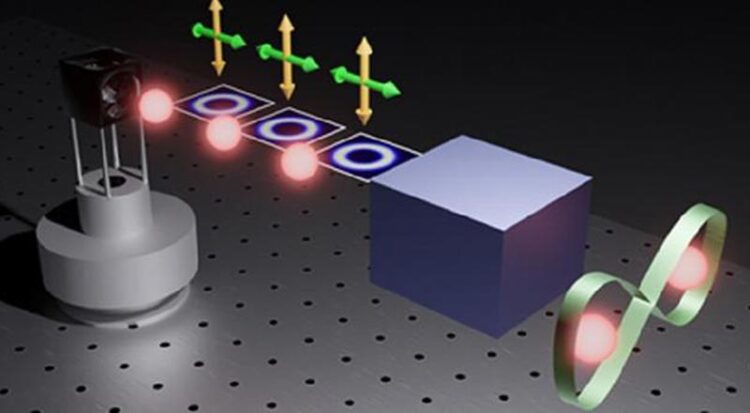Unlocking quantum potential

Scheme of the flexible platform implemented to engineer both intra- and interparticle Orbital Angular Momentum based entangled states via quantum dot source.
Credit: Nicolò Spagnolo
Harnessing high-dimensional quantum states with QDs and OAM.
Generation of nearly deterministic OAM-based entangled states offers a bridge between photonic technologies for quantum advancements.
Quantum technology’s future rests on the exploitation of fascinating quantum mechanics concepts — such as high-dimensional quantum states. Think of these as states basic ingredients of quantum information science and quantum tech. To manipulate these states, scientists have turned to light, specifically a property called orbital angular momentum (OAM), which deals with how light twists and turns in space. Here’s a catch: making super bright single photons with OAM in a deterministic fashion has been a tough nut to crack.
Now, enter quantum dots (QDs), tiny particles with big potential. A team of researchers from Sapienza University of Rome, Paris-Saclay University, and University of Naples Federico II combined the features of OAM with those of QDs to create a bridge between two cutting-edge technologies. Their results are published in the peer-reviewed Gold Open Access journal Advanced Photonics.
Conceptual scheme of the proposed protocol. Manipulating the polarization and OAM of single photons generated from a QD source in a nearly deterministic fashion, intraparticle entangled states are generated by making the two degrees of freedom interact through a q-plate. In the interparticle regime, two photons characterized by specific states in the hybrid space composed of polarization and OAM interfere using a beam-splitter. Post-selecting on the coincidence counts, a probabilistic entangling gate has been implemented. Credit: Alessia Suprano.
So, where is the innovation? This bridge they’ve built can be flexibly used for two goals. First, it can make pure single photons that are entangled within the OAM-polarization space, and the researchers can count them directly. Second, this bridge can also make pairs of photons that are strongly correlated in the quantum world. They’re entangled, so that each single photon state cannot be described independently of the other, even when they’re far apart. This is a big deal for quantum communication and encryption.
This new platform has the potential to create hybrid entanglement states both within and between particles, all belonging to high-dimensional Hilbert spaces. On one hand, the team has achieved the generation of pure single photons, whose quantum states exhibit nonseparability within the hybrid OAM-polarization domain. By exploiting an almost deterministic quantum source in combination with a q-plate — a device capable of adjusting the OAM value based on single photon polarization — the researchers can directly validate these states through single-photon counts, thereby avoiding the need for a heralding process and enhancing the rate of generation.
On the other hand, the team also employs the concept of indistinguishability within single photons as a resource to generate pairs of single photons that possess entanglement within the hybrid OAM-polarization space. According to Professor Fabio Sciarrino, head of Quantum Information Lab in the Department of Physics of Sapienza University of Rome, “The proposed flexible scheme represents a step forward in high-dimensional multiphoton experiments, and it could provide an import platform for both fundamental investigations and quantum photonic applications.”
In simple terms, this research is a leap in our quest for better quantum technologies. It’s like connecting two major cities. This connection opens exciting possibilities for quantum computing, communication, and much more. So, keep an eye on this — it’s not just science; it’s the future.
For details, read the original Gold Open Access research by Suprano et al., “Orbital angular momentum based intra- and interparticle entangled states generated via a quantum dot source” Adv. Photon. 4(4) 046008 (2023), doi 10.1117/1.AP.5.4.046008.
Journal: Advanced Photonics
DOI: 10.1117/1.AP.5.4.046008
Article Title: Orbital angular momentum based intra- and interparticle entangled states generated via a quantum dot source
Article Publication Date: 30-Aug-2023
Media Contact
Daneet Steffens
SPIE–International Society for Optics and Photonics
daneets@spie.org
Office: 360-685-5478
All latest news from the category: Information Technology
Here you can find a summary of innovations in the fields of information and data processing and up-to-date developments on IT equipment and hardware.
This area covers topics such as IT services, IT architectures, IT management and telecommunications.
Newest articles
Faster, more energy-efficient way to manufacture an industrially important chemical
Zirconium combined with silicon nitride enhances the conversion of propane — present in natural gas — needed to create in-demand plastic, polypropylene. Polypropylene is a common type of plastic found…

Energy planning in Ghana as a role model for the world
Improving the resilience of energy systems in the Global South. What criteria should we use to better plan for resilient energy systems? How do socio-economic, technical and climate change related…

Artificial blood vessels could improve heart bypass outcomes
Artificial blood vessels could improve heart bypass outcomes. 3D-printed blood vessels, which closely mimic the properties of human veins, could transform the treatment of cardiovascular diseases. Strong, flexible, gel-like tubes…





















